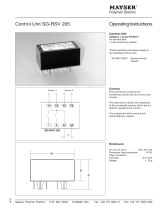
Memory
The Essentials of Enhanced Time Processing Unit, Rev. 1
Freescale Semiconductor 3
timing on a single event could be accurately determined by this hardware, the minimum setup time for a
second event was determined by system latency, as well as by the software service time for the first event.
This latency limited the minimum guaranteed time between pin actions.
Each eTPU channel provides two compare and two capture registers. With the modes selected properly, it
is possible to generate or measure pulses as narrow as one timebase count. Registers and buses are 24 bits
wide, which greatly extends the dynamic range of any function. A special Angle Clock subsystem can
drive one of the buses, allowing pulses to start or stop in various combinations of the time and angle.
The eTPU channel hardware can be configured to at least 13 distinct modes to meet a large number of
applications requirements. For each of these modes, match registers and capture registers can each be
connected to different timer-counter registers, providing another degree of flexibility. Finally, in some
microcontrollers, the input function of the channel may be internally connected to a different pin from the
output function. These multiple alternatives provide an extensive array of potential channel hardware
configurations. Some of the more interesting configurations are:.
• Single input capture or single output compare provides the original TPU functionality and should
be the starting point for any design.
• Input transitions can be made to capture both the time and angle of the transition.
• Input capture can be conditioned on combinations of matches. This provides the capability of
finding an expected pin transition in a window of time, angle, or combination matches.
• Multiple input captures can be used to detect and measure very small pulses.
• One match blocked by another, such as a drive signal triggering on a crank shaft angle, which is
inhibited by a timeout.
• One or two matches blocked by a transition.
• Output disable modes that can disable output drives immediately when an input signal is detected
outside of a predetermined window. This mode could protect an output drive circuit in the event a
short circuit is detected.
4Memory
When the TPU was first designed, it was seen as a somewhat oversized timer in a very large
microcontroller. The concept of multiple processing units on a single chip was untried in the market, so
every effort was made to keep the size of the module as small as possible. The TPU on the MC68332 was
introduced with just 2 Kbytes of code memory, which was shared between 32-bit microinstructions and
16-bit entry point vectors. The parameter space was 200 bytes arranged as 100 parameters distributed
among the 16 channels as six or eight local parameters for each channel, with a provision for any channel
to address memory allocated to a different channel. A few years after the original design, the TPU2
stretched the parameter space to 256 bytes and introduced a paging scheme for the program memory,
effectively raising the maximum limit to 8 Kbytes. Still, memory size was the factor that most often limited
applications.
The eTPU is designed with an addressable program space of up to 16K microinstructions (64 Kbytes),
which can be shared between two microengines. A particular function can be run on both microengines
simultaneously without any degradation of performance. In addition, each channel can now address up to












